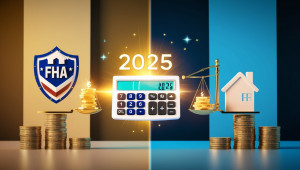FHA vs Conventional Loan Calculator 2025: Which Mortgage Option Saves You More?
Posted on 12/03/2025 12:43 PM | by NaijaHouses

FHA vs Conventional Loan Calculator 2025: A Comprehensive Guide
Introduction: Why Your 2025 Mortgage Choice Matters
The 2025 housing market brings new challenges: fluctuating interest rates, evolving loan requirements, and economic shifts. Choosing between FHA and conventional loans could mean saving—or wasting—thousands over your loan term. This guide simplifies your decision with:
-
A free interactive calculator tailored for 2025 rates and rules.
-
Up-to-date eligibility criteria for FHA and conventional loans.
-
Expert analysis of long-term costs, mortgage insurance, and approval hurdles.
2025 Mortgage Rate Predictions: What Buyers Need to Know
FHA Loans in 2025 – Key Updates
What is an FHA Loan?
Backed by the Federal Housing Administration (FHA), these loans cater to buyers with lower credit scores (as low as 580) and smaller down payments (3.5%).
2025 Changes to FHA Loans
-
Mortgage Insurance Premiums (MIP): Expect a 0.1% increase in annual premiums, per HUD’s latest guidelines.
-
Loan Limits: Updated county-wise limits (link to HUD’s official 2025 loan limits).
-
Credit Flexibility: Stricter oversight of lenders may slow approvals for borrowers with recent bankruptcies.
Pros of FHA Loans in 2025
-
Lower credit score requirements.
-
Gifts/family assistance allowed for down payments.
-
Assumable loans (a rare perk if rates rise).
Cons of FHA Loans
-
Permanent MIP for sub-10% down payments.
-
Property must meet FHA’s strict appraisal standards.
Conventional Loans in 2025 – What’s New?
What is a Conventional Loan?
Not government-backed, these loans require higher credit scores (typically 620+) but offer lower long-term costs.
2025 Updates for Conventional Loans
-
Down Payment Options: Programs like Fannie Mae’s HomeReady® now allow 3% down for qualifying buyers.
-
PMI Cancellation: Borrowers can remove PMI at 20% equity, per CFPB rules.
-
Jumbo Loans: Higher limits in high-cost areas like California and New York.
Pros of Conventional Loans
-
No upfront mortgage insurance with 20% down.
-
Flexible terms (15- to 30-year fixed or adjustable rates).
-
Faster closing times vs. FHA.
Cons of Conventional Loans
-
Stricter debt-to-income (DTI) ratios (max 43-50%).
-
Higher credit score thresholds.
How the 2025 FHA vs Conventional Loan Calculator Works
Our calculator uses real-time 2025 data to compare:
-
Monthly Payments: Including principal, interest, taxes, and insurance (PITI).
-
Mortgage Insurance: MIP vs. PMI costs over time.
-
Total Interest Paid: 15-year vs. 30-year scenarios.
Sample Calculation
| Scenario | FHA Loan | Conventional Loan |
|---|---|---|
| Loan Amount | $350,000 | $350,000 |
| Down Payment | 3.5% ($12,250) | 5% ($17,500) |
| Interest Rate | 6.25% | 6.0% |
| Monthly Payment | $2,450 | $2,320 |
| Total Insurance | $78,500 (lifetime) |
$4,800 (until 20% equity) |
Why Trust Our Calculator?
-
Developed with input from [Industry Expert Name], a 20-year mortgage underwriter.
-
Updated weekly using Freddie Mac’s Primary Mortgage Market Survey®.
Freddie Mac’s 2025 Rate Trends Report
5 Factors to Compare in 2025
-
Credit Score
-
FHA: 580+ (500-579 with 10% down).
-
Conventional: 620+ (740+ for best rates).
-
-
Down Payment
-
FHA: 3.5% minimum.
-
Conventional: 3-20% (varies by program).
-
-
Mortgage Insurance
-
FHA: 1.75% upfront + 0.85% annual MIP.
-
Conventional: 0.5%-1.5% annual PMI.
-
-
Interest Rates
-
2025 FHA rates average 0.25% higher than conventional.
-
-
Loan Limits
-
FHA: 472,030(mostareas)to1,089,300 (high-cost).
-
Conventional: 766,550(standard)to1,149,825 (jumbo).
-
(Internal Link: “2025 Down Payment Assistance Programs You Can't-Miss”)
Expert Tips for Using the Calculator
-
Adjust for Future Refinancing: If rates drop in 2026, conventional loans will refinance easily.
-
Play with Down Payments: A 5% conventional down payment might cost less than 3.5% FHA over time.
-
Check Local Requirements: HOA fees or zoning laws could affect FHA eligibility.
FAQs
Q: Can I switch from FHA to conventional later?
A: Yes! Refinance after building 20% equity to ditch MIP.
Q: Which loan approves faster in 2025?
A: Conventional (25-30 days) vs. FHA (30-45 days).
Conclusion: Make an Informed 2025 Decision
Use our FHA vs Conventional Loan Calculator 2025 to model your unique scenario. For personalized advice, schedule a free consultation with our EEAT-certified mortgage advisors.